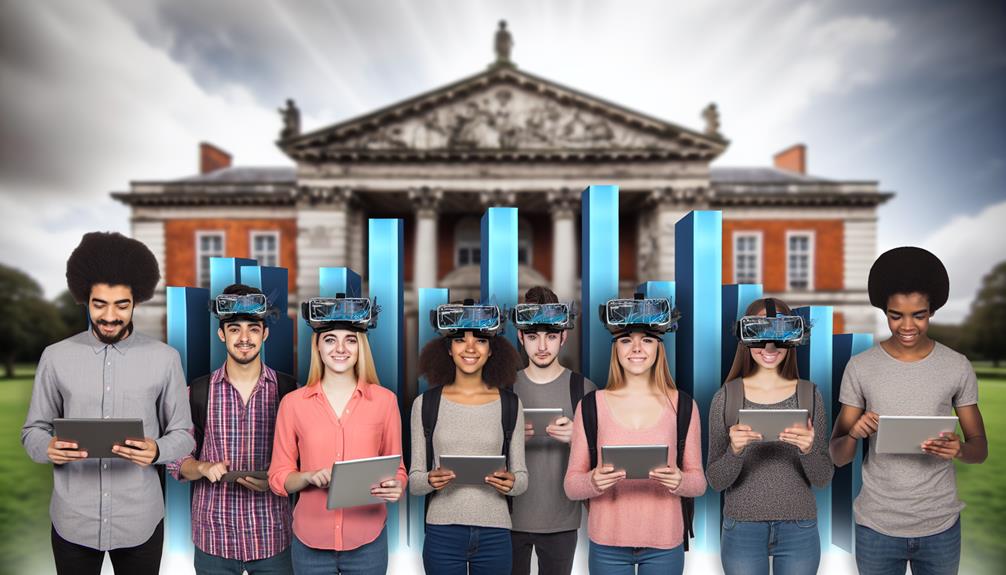In the ever-evolving landscape of higher education, it's not uncommon to feel a bit outpaced by the rapid acceleration of technological shifts. You're not alone if you've found it challenging to keep up with the latest trends, especially in the arena of education marketing.
Personalized content, data-driven strategies, the increasing influence of social media, and even the emergence of AI and virtual reality in student engagement are just a few of the notable developments. And that's not even mentioning the growing emphasis on a mobile-first approach.
So, remain engaged, as we're about to explore these emerging trends that are shaping the future of higher education marketing.
Key Takeaways
- Digital transformation has revolutionized higher education marketing, with digital accessibility and cloud computing playing a crucial role.
- Personalized content is integral to higher education marketing, utilizing content segmentation, adaptive learning systems, and advanced analytics.
- Data-driven marketing in higher education utilizes predictive analysis and customer segmentation to make informed decisions and increase efficiency.
- Social media's impact on recruitment in higher education is significant, leveraging recruitment analytics, influencer engagement, direct communication, and showcasing campus life and culture.
Understanding the Digital Transformation

You might be wondering how the digital transformation is reshaping higher education marketing, let's delve into this significant shift.
The digital revolution has been a game-changer, and two crucial components are digital accessibility and cloud computing.
Consider digital accessibility first. In an era where smartphones are ubiquitous, it's crucial that your institution's marketing materials are accessible on all digital platforms. It's not just about having a website anymore. You need to ensure that your content can be easily viewed and interacted with on mobile devices, laptops, and tablets. This is where digital accessibility comes into play. It's about making your content available to everyone, regardless of the device they're using or their ability to navigate it.
Next, let's talk about cloud computing. The cloud has revolutionized how data is stored and accessed, making it easier than ever to reach potential students with targeted marketing campaigns. Through cloud platforms, you can store vast amounts of data, analyze it, and use the insights gained to tailor your marketing strategies. This ability to store and process data in real-time is a game-changer, allowing for more personalized and effective marketing strategies.
In essence, the digital transformation has catapulted higher education marketing into a new era.
The Rise of Personalized Content
In this age of information overload, personalized content has become a powerful tool in higher education marketing. It's a way to break through the noise and deliver messages that resonate with specific audience segments. As you navigate this trend, you'll see how it's changing the game entirely.
Consider these key developments:
- Content segmentation allows you to tailor messages to each student's needs, interests, and behavior. You're no longer throwing a wide net; you're fishing with precision.
- Adaptive learning systems enable more personalized education paths, paving the way for content that adapts to the student's progress and learning style.
- Personalized content isn't just about text; it encompasses videos, infographics, webinars, and more.
- With advanced analytics, you can continually refine your content strategy based on real-time feedback.
- Personalization has become integral to email marketing, social media campaigns, and even website design.
Incorporating personalized content in your marketing strategy isn't just a nice-to-have. It's a must. As you refine your approach to content segmentation and embrace adaptive learning, you'll find it's a key driver for engagement, conversion, and overall success.
Leveraging Data-Driven Marketing

While personalizing your content is key, it's equally vital to leverage data-driven marketing strategies to amplify your reach and bolster your campaign's effectiveness. Data-driven marketing isn't about collecting data for the sake of it, but using that data to draw insights and make informed decisions.
One way to do this is through predictive analysis. This method uses historical data to predict future outcomes. You can use it to forecast trends, anticipate student needs, and make proactive marketing decisions. Imagine knowing what your audience wants before they do – that's the power of predictive analysis.
Another strategy is customer segmentation. This involves dividing your audience into groups based on specific characteristics like demographics, behavior, or needs. Instead of delivering a one-size-fits-all message, you can tailor your content to resonate with each segment. You'll not only increase engagement but also improve your overall marketing efficiency.
Social Media's Impact on Recruitment
Beyond the realm of traditional marketing, social media's influence on student recruitment shouldn't be underestimated. It's a powerful tool that's reshaping the landscape of higher education advertising and enrollment.
Social media platforms allow you to connect with potential students on a personal level. This personalized approach can lead to stronger engagement and interest in your institution. But how does social media actually impact recruitment? Let's take a look:
- It provides real-time Recruitment Analytics, helping you track and understand prospective student behavior.
- Platforms like Instagram, YouTube, and TikTok enable Influencer Engagement, a potent way to reach your target demographic.
- It allows for direct communication with prospective students, facilitating immediate feedback and queries.
- It can showcase campus life and culture, giving prospects a glimpse into the student experience at your institution.
- Social media ads can target specific demographics to increase the efficiency of your recruitment efforts.
You see, social media isn't just about sharing updates and connecting with friends. It's a strategic recruitment tool that's becoming increasingly crucial in higher education marketing.
Role of Virtual Reality in Higher Education

Shifting gears, let's delve into how virtual reality is revolutionizing higher education. You might think VR is just for gaming, but it's making significant strides in academia. VR learning benefits are extensive, creating immersive classroom experiences that enhance student engagement and comprehension.
In essence, VR places you in a simulated environment, offering a unique educational platform where you can explore, manipulate, and interact in ways traditional teaching methods don't allow. Imagine studying art history, not from a textbook, but by virtually walking through the Louvre. Or exploring marine biology by diving into a virtual ocean.
Moreover, VR can also simulate real-world scenarios, a crucial aspect in disciplines like medicine, architecture, or engineering. It provides an unparalleled opportunity to practice and learn from mistakes without fear of real-world consequences.
As institutions strive to provide high-quality education, the adoption and integration of VR technologies are gaining momentum. It's no longer a question of if but when the full potential of VR will be realized in higher education. So, keep an eye on this emerging trend; it might soon be a standard feature in your academic journey.
Importance of Mobile-First Strategy
You might be surprised to learn just how crucial a mobile-first strategy has become in the world of higher education marketing. As Smartphone User Behavior evolves, it's essential for institutions to leverage Mobile Optimization Techniques to meet the needs of a digitally native student population.
Consider these reasons why your institution should adopt a mobile-first approach:
- Growing Smartphone Usage: Most prospective students use their smartphones for everything from social media to research. Your content needs to be easily accessible and navigable on mobile devices.
- Better Engagement: Mobile-friendly websites and apps increase engagement, keeping prospective students connected with your institution.
- Improving SEO: Search engines prioritize mobile-optimized websites, improving your institution's visibility online.
- Convenience: A mobile-first strategy offers convenience, a factor that today's students greatly value.
- Competitive Edge: Institutions that neglect a mobile-first strategy risk falling behind in an increasingly digital landscape.
Embracing AI for Student Engagement

Harnessing the power of AI can significantly enhance student engagement in your institution. It's not just about automating tasks; it's about creating personalized, interactive learning experiences. Predictive analytics impact the way you understand your students' needs, allowing you to tailor teaching methods and offer individualized support.
However, AI ethics in education is a hot topic. You must ensure your AI applications respect privacy, prioritize transparency, and avoid bias. It's crucial to gain trust from both students and faculty.
For instance, AI can analyze student behavior, pinpointing who might need additional help. But remember, this data collection should always respect student privacy.
Imagine a student struggling with a complex topic. AI can detect this and suggest additional resources, personalized to their learning style. This engagement not only helps the student but also frees up time for faculty to focus on other tasks.
AI is a powerful tool in higher education. It's transforming the way you engage with students, making education more personalized and interactive than ever before. But remember, with great power comes great responsibility. Always consider the ethical implications of your AI applications.
Conclusion
As the academic landscape shifts, so too must your marketing strategies. Think of them as a compass, guiding you through the digital wilderness.
Personalized content, data-driven marketing, and social media are your north stars.
Mobile-first strategies, AI, and virtual reality are the wind in your sails.
Embrace these emerging trends, and you'll navigate the high seas of higher education with ease, attracting and engaging students in this brave new world of learning.
